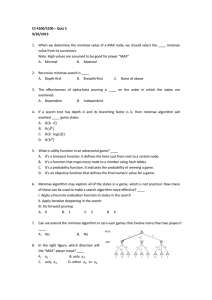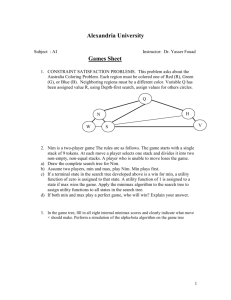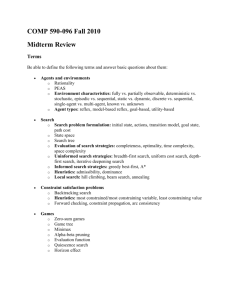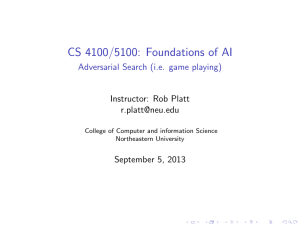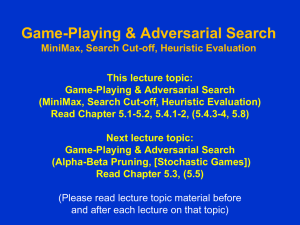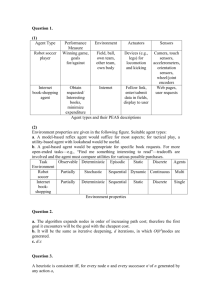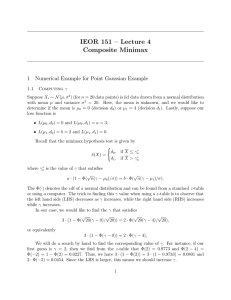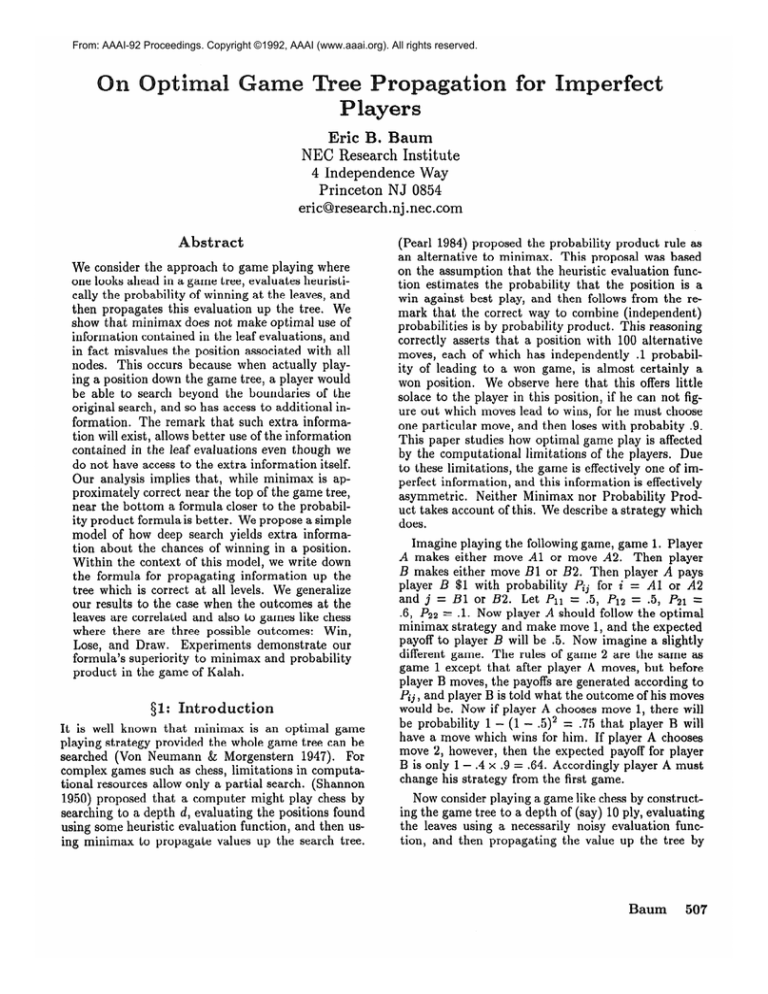
From: AAAI-92 Proceedings. Copyright ©1992, AAAI (www.aaai.org). All rights reserved.
Eric
awn
NEC Research Institute
4 Independence Way
Princeton NJ 0854
eric@research.nj .nec.com
bstract
We consider the approach to game playing where
one looks ahead in a game tree, evaluates heuristically the probability
of winning at the leaves, and
then propagates
this evaluation
up the tree. We
show that minimax does not make optimal use of
information
contained in the leaf evaluations,
and
in fact misvalues the position associated with all
nodes. This occurs because when actually playing a position down the game tree, a player would
be able to search beyond the boundaries
of the
original search, and so has access to additional
information.
The remark that such extra information will exist, allows better use of the information
contained
in the leaf evaluations
even though we
do not have access to the extra information
itself.
Our analysis implies that, while minimax
is approximately
correct near the top of the game tree,
near the bottom a formula closer to the probability product formula is better. We propose a simple
model of how deep search yields extra information about the chances of winning in a position.
Within the context of this model, we write down
the formula for propagating
information
up the
tree which is correct at all levels. We generalize
our results to the case when the outcomes at the
leaves are correlated and also to games like chess
where there are three possible outcomes:
Win,
Lose, and Draw.
Experiments
demonstrate
our
formula’s superiority
to minimax and probability
product in the game of Kalah.
$1:
Introduction
It is well known that minimax
is an optimal
game
playing strategy provided the whole game tree can be
searched (Von Neumann
& Morgenstern
1947). For
complex games such as chess, limitations
in computational resources allow only a partial search. (Shannon
1950) proposed that a computer might play chess by
searching to a depth d, evaluating
the positions found
using some heuristic evaluation function, and then using minimax
to propagate
values up the search tree.
(Pearl 1984) proposed the probability
product rule as
an alternative
to minimax.
This proposal was based
on the assumption
that the heuristic evaluation
function estimates
the probability
that the position is a
win against best play, and then follows from the remark that the correct way to combine (independent)
probabilities
is by probability
product. This reasoning
correctly asserts that a position with 100 alternative
moves, each of which has independently
.l probability of leading to a won game, is almost certainly
a
won position.
We observe here that this offers little
solace to the player in this position, if he can not figure out which moves lead to wins, for he must choose
one particular
move, and then loses with probabity
.9.
This paper studies how optimal game play is affected
by the computational
limitations
of the players.
Due
to these limitations,
the game is effectively one of imperfect information,
and this information
is effectively
asymmetric.
Neither Minimax nor Probability
Product takes account of this. We describe a strategy which
does.
Imagine playing the following game, game 1. Player
A makes either move Al or move A2. Then player
I3 makes either move Bl or B2. Then player A pays
player B $1 with probability
Pij for i = Al or A2
and j = Bl or B2. Let Prr = .5, I32 = .5, P21 =
.6, P22 = .l. Now player A should follow the optimal
minimax strategy and make move 1, and the expected
payoff to player B will be .5. Now imagine a slightly
different game. The rules of game 2 are the same as
game 1 except that after player A moves, but before
player B moves, the payoffs are generated according to
Pij, and player B is told what the outcome of his moves
would be. Now if player A chooses move 1, there will
be probability
1 - (1 - .5)2 = .75 that player B will
have a move which wins for him. If player A chooses
move 2, however, then the expected payoff for player
B is only 1 - .4 x .9 = .64. Accordingly
player A must
change his strategy from the first game.
Now consider playing a game like chess by constructing the game tree to a depth of (say) 10 ply, evaluating
the leaves using a necessarily
noisy evaluation
function, and then propagating
the value up the tree by
Baum
507
:
minimax.
We claim this minimax propagation
makes
suboptimal
use of the information
contained in the leaf
evaluations.
The notion of minimax is to assign values
to the positions associated with the nodes 9 ply deep
by taking the maximum value (to the opponent, player
B) of the accessible positions 10 ply deep, just as we
assigned a value to player B’s position at a depth of 1
ply in game 1 above. But, just as in game 2 above, our
opponent has much better information
about whether
the outcome is a win or a loss for him than is contained
in our evaluation
function.
This is because, when he
comes to play in this position, he will search it 10 ply
deep! Thus we should assign a value to our opponent,
of being in this position, according to a formula closer
to the probability
formula useful in game 2, than the
minimax formula useful in game 1. In general we expect a smooth interpolation
between using a formula
near probability
product deep in the search tree and
using a formula near minimax near the top of the tree.
We assume the evaluation
function
estimates
the
probability
of winning
at a position in actual play.
In minimax
only rank ordering of positions matters,
so standard
evaluation
functions
may require monotonic but nonlinear
resealing.
One may train evaluation functions to represent probability
by accumulating
statistics (Pearl 1984).
Besides (Pearl 1984) there have been other previous studies of alternative
propagation
schemes.
(Chi
& Nau 1989) claimed, for the game of three hole kalah,
that probability
product outperforms
minimax for the
same depth of search. In our experiments,
see $5, we
found minimax far superior to probability
product and
attribute
their result to the fact that they only worked
at depth 2 ply. Another approach was that of (Slagle and Dixon 1969) who remarked that the evaluation
function was a noisy version of the truth and that minimax is suboptimal
because it ignores the fact that “it is
valuable to have several good alternatives
in a planned
course of action”. Their M&N procedure assigns to a
max(min)
node some heuristic function of the M(N)
highest(lowest)
valued successors.
We will not have space here to discuss issues of time
complexity
beyond remarks in this paragraph.
The
alpha-beta
pruning algorithm
computes the exact result of minimaxpropagation
in time roughly the square
root of that required by brute force calculation.
Now
we argue that ‘the exact result of minimax propagation’ is only an approximation
to the correct propagation.
Nonetheless,
approximate
use of information
from a larger tree might likely be better than optimal use of information
from a smaller tree. For this
reason one should not expect practical improvements
from the propagation
algorithms
discussed in this paper without addressing
the question of pruning.
We
are here concerned only in principle with optimal use
of the information.
Once we understand
what calculation is in principle
optimal,
we may consider how
to efficiently approximate
it. An expanded version of
508
Problem Solving: Search and Expert Systems
this paper (Baum 1991) shows that much of the computational
benefit of alpha-beta
pruning can be taken
over into propagation
using truncated
versions of our
formula. Thus one can efficiently compute a better approximation
than minimax to the information-optimal
A still more promising approach is also
propagation.
Recently
a number of authors
under investigation.
(McAllester
1988), (Rivest 1988), (Russell & Wefald
1991), have proposed algorithms
for growing a search
tree including only relevant nodes. Ideas of these authors on pruning can be readily complemented
by the
results in the present paper on propagation.
By combining ideas from these authors,
some new algorithmic ideas, and the information
theoretic results of the
present paper, we believe that improved search algorithms can be produced.
This will be discussed elsewhere (Baum & Smith 1992).
$2 derives a formula useful for propagating
evaluations up game trees. 53 describes the approximations
inherent in the formula of $2 and when it is optimal.
$4 discusses generalization
to the case of correlated
probabilities.
§5 describes experiments
on the game
of Kalah. $6 is a summary.
52: An Interpolation
and Probabillistic
Combination
Consider
the following one person game, game 3.
Player A has b possible moves. A referee declares move
pi. He does not
i E (1, . . . . . b} a Win with probability
tell player A these outcomes,
however, until after A
moves. Instead he supplies to player A b bits of inp”h given
formation
hi, where hi is 1 with probability
that move i is a Win, and is 1 with probability
1 - pi
given that, move i is a Loss. Player A knows the pi and
pzw and pi.
Game 3 is a model of deep search in a game like
chess. Think of hi as a hint about the value of move
i. For appropriate
p*h and pi, ha models the extra information,in
deep search relative to simple evaluation.
If paw = p; = 1, ha tells the exact outcome, and game
3 is like game 2. If pi; = pi = i, there is no extra
information,
and game 3 is like game 1.
What is the value V of game 3 to player A? By Bayes
law,
P(i = WI/& = a) = P(hi
=
ali = W)P(i
= W)
P(hi = a)
’
(2.1)
The notation
should be evident.
For
Here a = 0,l.
example by P(i = Wlhi = 1) we mean the probability
that move i leads to a win given that hi is 1. Now
P(hi = 1) = P&Pi + (1 - z&)(1 - Pi)
P(hi
=
0)
=
(1 -P”;v)(Pi)
+&(I
-Pi)
(2.2)
(23
so
P(i = Wjha = 1) =
Pi&Pi
P&pi + (1 - p”,)( 1 - pi)
(2’4)
P(i = Wlhi = 0) =
(1 - Pk)Pi
(1 - P&&i)
+ pi(l
- pi)
(2*5)
We now calculate
the probability
V of winning
for player A who uses Bayes optimal strategy.
Let
P(i,a)
f P(i = WJhi = a). Order the moves so
P(i, 1) 2 P(i + 1,l) for all i. Let c be the smallest
number for which an i satisfies P(i, 0) 2 P(c+ 1,1) (if
there is no such number let c = b). Let ic be arg max
P(i, 0). Then
(Pi0 - P”w) + (1 - Pi)(P”l))
j=l,c
i=l,j-1
(l-P%)
+pio Pi,(l
X
- &)
(Pi(l - Pb)
+ (1 - Pi,)(&)
+ (1 - Pi)(Pi))
(24
i=l,c
When hl = 1, the Bayes optimal choice is move 1 (i.e.
eqn’s 2.4 and 2.5 imply move 1 is most likely to win,
independent
of hi for i # 1). The payoff then is pl.
This is the first term in the sum. When hl = 0, ha = 1
player A picks move 2. This has payoff p2 and occurs
with probability
(pl(l - pw) + (1 - pl)(p~))pw
since
h2 = 1 with probability
pw when move 2 is a win and
(1 -pw) when the first move is
h = 0 with probability
a Win or with probability
pi when the first move is a
Loss. This yields the second term in the sum. Finally
if hi = 0 for i = 1,2, . . . . c, the Bayes optimal choice is
move ie. This event yields the last term.
Note that we recover the appropriate
values in the
limiting cases. When player A has no additional
information beyond the pi, i.e. when Vi : psw = pi = 3,
then c = 1 and V = PIPW t: PI(~ T PW) = PI, the
minimax value. When Vi : pzw = pi = 1, the limit
of perfect information,
then c = b and we recover the
probability
formula V = 1 - n,=,,,(l
- pi). Note also
that formula 2.6 can easily be computed in time O(c)
(once we sort the pi).
In human
chess play, consideration
of drawing
prospects
is important,
particularly
in endgames.
Many standard
chess programs seem relatively
weak
in both their consideration
of drawing prospects and
their handling
of endgames.
The arguments
of this
section can be readily generalized to games with three
outcomes:
Win, Lose, or Draw. We compute at each
position both the probability
of Winning and of Drawing and can then make move decisions based on overall
Utility of the prospects.
Equations
analagous
to 2.6
can be derived for propagating
VW (the probability
of
winning) and Vr, (the probability
of drawing) up the
search tree. One may also perform calculations
involving conditional
probabilities.
(Humans will frequently
enter into a line of play which they are confident can
be drawn but preserves winning chances.)
Details are
contained in the long version (Baum 1991).
53: A Model of Deep Search
In this section we will first derive an exact formula,
which optimally
propagates
leaf evaluations
up a tree
given essentially
as much knowledge as one might in
principle gather about how time for analysis improves
evaluation of outcome. Formula 2.6 will arise as an approximation,
making more realistic assumptions
about
how much we know about how deen search and analysis improves on simple heuristic e;aluation.
Formula
2.6 will be seen to be exact in a simple model of evaluations studied by (Schriifer 1986), and for this model
we will give the appropriate
pw and pi.
We wish first to calculate the probability
V that our
opponent
will win in a position where he has b possible moves and we have evaluated by using our simple
heuristic evaluation
function the probability
that he
wins if he makes move i as pi. For generality, let Xi denote the value(s) of any (collection) of other functions
of the positionwhich
might be useful. So, e.g., X might
include an estimate of how “tactical”
the position is,
if we believe deep search to be more informative
relative to simple evaluation in “tactical” positions than in
more “positional”
situations.
We will thus evaluate V
in terms of (1) our heuristic evaluation of the probability of winning of its successors, and (2) an estimator,
which we may previously
train on &me large set of
games, of how much deep search improves evaluation
relative to our simple heuristic evaluator, where we allow this estimator to depend on a small number of features. This estimator
will be called P(qlp+, Xi) which
we define to be the probability
that extended
analysis when actually playing this position, say by depth
d search, will lead to the estimate that the nrobabilitv
of winning by playing move i is between q and q + di.
Now we have
1
dq q x (Probability
v=
highest
evaluated
move has
s 0
probability
q).
(34
The highest evaluated
move has probability
estimate
Q provided
(a) none of the b alternatives
has estimate higher than q>and 04 at least one has probability estimate
q . (Note this means between q and
q + dq. For pedagogical
clarity we omit epsilantics
wherever possible.) The probability
that none of the b
moves is estimated to have probability
higher than q is
[niZl,*(l
- s,’ dq’ P(q’Ipi, Xi))]. The probability
that
move .i has evaluation
Q,
given
that
it
does
not
have
-. P(&.Q,Xi)
evaluation
higher than q is
Thus
C1-JalW
p(q'lPi,Xi))'
the probability
that at least one of the b moves has
probability
q, given that none of them has evaluation
higher than q, is {l-ni=l,a(lp(q’pllxi)
)}.
(1-J;
Putting
this together
V=lldy
w
P(dlPlJi))
we find
q[iQa(l-ildd
- 8
p(CtlPi,xi))l
Baum
509
i=l,b
f%lPi’ Xi>
>I
(1 - 1; 4’ fwlPa, w>
(3.2)
More generally, we must compute the probability
of
winning at a node at level I + 1 in the search tree,
given that we have calculated, by propagation
up from
the leaves, that the probability
of winning if we choose
move i is pi. To do this we measure the distribution
P(qlp{, Xi), and we have simply
Unfortunately
the utility of this formula is limited by
any practical limitations
in our ability to approximate
P(qlpi, Xi). We propose equation
2.6 as a simple approximation
which is easy to use and reasonably accurate. The approximation
inherent in 2.6 is that q can
take on only one of two values, given pi and Xi, Thus
P(qlpi,&)
is simply the sum of two delta functions.
These two values are given by eqns. 2.4 and 2.5. One
value (corresponding
to hi = 1) is a revised estimate
of winning is
from depth d search that the probability
higher than depth 1 search estimates,
and the other is
a revised estimate that the probability
is lower.
In fact equation 2.6 can be seen to be exact in the
widely studied model where the evaluation function is
Boolean, returning
either 0 or 1, and where our knowledge of correctness of our evaluation
is dependent only
on depth of search, and not on other features of the
position.
This second condition occurs, e.g., if we neglect (as is common in game programs)
to estimate
feature dependence
of the accuracy of our calculation.
Under these assumptions,
if depth d search, returns
a 1 (respectively
a 0)) we assign a certain probability
pz (respectively
pi) that the position is Won. Accordingly P(qlpf) is bivalued and equation 2.6 exact. These
conditions hold, e.g. in the model studied by (Schriifer
1986) and in the related model of (Nau 1983).
(Schriifer
1986) studied the following model.
We
build a game tree starting from the root, which may
be either a Win or a Loss node, and grow a tree with
uniform branching ratio b. Below every Win node there
are n Loss nodes and b - n Win nodes (where we define
node values with respect to the player on move). By
definition, a Win node must have at least one winning
option, so n 2 1. Below every Loss node, again by
definition,
all b children are Wins. The tree is built
to depth d. A heuristic evaluation
function returns a
noisy estimate of the true value of the leaves as follows.
If the leaf is a Win node, the evaluation
is e = 1 with
et)
probability
1 - et (and thus 0 with probability
and if the leaf is a Loss node, the evaluation
is 0 with
probability
1 - eo (and thus 1 with probability
ei).
Now (Schriifer 1986) derives recursion relations relating the probability
of error at level I + 1 above the
510
Problem Solving: Search and Expert Systems
leaves to that at level 1 (denoted
e:), assuming
evaluation
is propagated
up the tree by minimax:
ef& = (eF)n(l-e;t)b-n
; e&
= l-(l-e,+)b
the
(3.4)
Analyzing
these equations,
(Schriifer
1986) showed
that deep search is pathological
(i.e. gets worse the
deeper you search) provided n = 1, but is at least exponentially
convergent
to zero error (i.e. e+ h* 0 and
- N 0) if n > 1 and e$ and ei are sufficiently small.
TSchriifer 1986) a 1so analyzed a somewhat more complex model, where n is an i.i.d. random variable at
each Win node in the tree, chosen with probability
pj
to be j for j = 1 up to b. These results cast considerable light on the question,
hotly debated in the
theoretical
AI literature
for ten years, of when game
search is pathological.
In Schriifer’s model we may calculate
how deep
search improves the accuracy of our evaluation.
Also,
since the evaluation
function is bivalued, and since accuracy depends only on depth of search (rather than
say other parameters
of the position or game tree) the
evaluator P(qlel) is is in fact zero except for two values of q. In (Baum 1991) we calculate explicitly in this
model P(qlel) an d s h ow that equation 3.3 reduces exactly to equation 2.6 for appropriate
values of pw and
pi. One demands that pw and pi be chosen so that
the probability
of winning given by eqns 2.4-5 is equal
to that given by depth d search. We omit the lengthy
Bayesian calculation
for reasons of space but state the
values of pw and pi which emerge. We find
P&4) =
PN
=
P&4) =
(1 - ed+)(l-
er+ - ea + e;teg
-
e,e;f)
(1 - el+)(l - e$ - eJ)
(1 -
- e, + e;ted - e,e:)
(e;)(l
- ez - ed)
(1 - e$)(ef- -eJ+ele$(e;t)(l - ed+ - ed)
hi)
(3.5)
, ,
(3.6)
(3.7)
- er - ef + e,e$ - er+ea)
(3.8)
(1- el)(le$ - ez)
These formulae tell us how to calculate the pw and
pi and use formula 2.6. Here the superscripts
on pw
and pr, correspond
to the superscripts
i in eqn 2.6 as
follows. One should use superscript
1 (eqns 3.5-6) in
equation 2.6 for moves i with pi 2 $ and one should
use superscript
0 (eqns 3.7-8) for moves with pi < a.
Recall that et (resp. el) is defined as the probability
that a depth I search predicts a state is lost (resp.
won) when in fact it is won (resp. lost) (and ef is
simply e: for I = d). The ef and e: are thus directly
measurable
by taking statistics.
Alternatively,
they
may be calculated
in Schrcfer’s model. If our search
is accurate, it will be a good approximation
to neglect
both ef and ef with respect to 1. This yields:
POLU)=
(1 - ed)(l
6
Ptv =l’p~=1---;p&=1---$‘p~=1
6
(3.9)
Thus convergence
to perfect information
is linear in
the ratio of the accuracy of depth d search to depth 1
search. (Schriifer 1986) shows that, when deep search
is not pathological,
it is typically at least exponentially
convergent.
Thus pw and pi are likely near one for
many levels in a search tree.
54: Correlations
So far we have proceeded under the assumption
that
that probabilities
pi of winning are independent.
Since
these are probabilities
of winning of positions differing
by only two moves, they more realistically
should be
considered correlated.
Note that we are not concerned
with correlations
in the distribution
of the values of
the pi. This kind of correlation
implies that if p = .9
for a position, than a sibling position is likely to have
p 2 .5. This must occur, for if nearby positions are
not more likely to lead to similar results, we could not
play using a heuristic evaluation
function.
Instead we
are discussing now correlations
between the outcomes,
given the probabilities.
This kind of correlation occurs
when two siblings each have p = .8, but the probability
that either sibling wins is less (or more) than 1 - .22.
In (Baum 1991) we give a more general discussion
of correllations.
Here for conciseness we specialize to
a simple assumption
about the form of correlations.
This assumption
seems plausible as an approximation,
and is simple enough to allow a readily computable
formula.
Since we have little idea about the nature
of the correlations
in practice it also seems reasonable
to choose a model which allows a one parameter
fit.
Our simplified model follows. Correlation
is specified
by one parameter:
y. Given pl 2 p2 1 ., . 2 pi, we
determine
which moves lead to a win as follows.
A
referee first draws a bit Bc which has probability
ypk
of being 1. If Bc is a 1, then all moves, l,..., L are
W. If Bc is a 0, then move i : i = 1, . . . , k: is a W
with probability
pa - ypk, where all of these are now
determined
independently.
Note we don’t care what
happens for i > Ic, because we assume either that these
moves are totally correlated with move 1, or because in
any case the combination
of their correlation
plus low
probability
means the player should never select them,
independent
of the hi, or because we simply consider
strategies which truncate after considering
the Ic best
moves. If we only consider strategies which truncate
after 2 moves (i.e. if k=2) this model of correlations
can be easily seen to be without loss of generality.
Now it is easy to write down the analogue of equation
2.6,
2.6. Let V(pl,p2, . . . . pk) be defined by equation
where c --) Ic. For i = 1, . . . . Ic let
(54
Call the value of the position,
relations, V’. Then
in the model
v’ = -/Pk + (1 - YPk)V(i?
with cor-
(5.2)
This is evident since with probability
TpI,, Bc = 1,
the probability
and the position is a win. Otherwise,
of winning is V(g).
Note that in the limit of perfect
correlation,
i.e. y = 1 and p!, = ~2, we recover the
minimax value pl , since then pi = 0, and so we discover
in computing
V(g) that c = 1 and 5.2 reduces to 7~2+
(1 - TPa)P: = Pl*
§5: Experiments
with
alah
This section describes preliminary
experiments’
comparing performance
of programs using minimax, probability product, and formula 2.6 on the game of Kalah.
Kalah has been described as a “moderately
complex
game, perhaps on a par with checkers” (Slagle & Dixon
1970). See (Slagle & Dixon 1969) for a discussion of
the rules.
We mention here only that the object of
Kalah is to capture stones.
As evaluation
function (Slagle & Dixon 1969) proposed and (Chi & Nau 1989) studied Kalah Advantage
(KA) defined as the difference in number of stones currently captured (scaled to be between 0 and 1 to estimate a probability
of winning).
We found this did not
adequately
estimate
the probability
of winning.
Instead we used the following. Define SrKA/NR
where
NR is the number of stones remaining
on the board
(and thus potentially
winnable).
Our evaluation function then was El - (1 - S)/2.
In head to head comE played a subpetition using depth 6 ply alpha-beta,
stantially
stronger
game than KA. Note that when
KA=NR
(so that a mathematical
win or loss has occurred) E is 1 or 0, and when KA=O, E = l/2. This is
a reasonable estimate of the probability
of winning for
KA=O, but not precise since the side on move has an
advantage (about 53% in our tournament).
More comprehensive experiments
might take statistics
to find a
nonlinear,
monotonic resealing of E which more closely
estimated probability
of winning. This would presumably increase the edge of formula 2.6.
We simply chose to set, for E a parameter:
Pw =PL=l-2
+cd-l)
where d = 6 was the depth of our search and 1 =
0 9 “‘> 4 was the level above the leaf. The exponential
form was suggested by the dependence of pw and pi in
equations 3.9 on el and ed and the exponential
increase
in accuracy of deep search in Schriifer’s model. Note
that for this first cut we approximated
by setting pw =
pi and by setting both independent
of all other factors,
including pi, the probability
the move will win. More
accurate tuning up of the piw and pi would be possible
with more work. Presumably
this would improve the
performance
of formula 2.6. A small tournament
was
played on 400 games for values of E = .8,.85,.9, and .95.
Formula 2.6 seemed to have an edge against minimax
‘These experiments were performed by E. Wigderson
using code partially written by W. D. Smith.
Baum
511
for each of these values, but the edge was largest for c =
.9 so we then performed a tournament
of 20,000 games
for this value. Note E = .9 corresponds
to relatively
modest choices of pw and pi. By parametrizing
pw
and pi in this way and choosing E to maximize results,
we implicitly
tuned against the degree of correlation,
and the modest values of pw and pi may reflect a fair
degree of correlation.
Tournaments
were performed
by choosing 10,000
starting positions by making the first 6 moves at random. For each of these starting positions competitor
A and B played both First and Second, where A and
B could be any of minimax, formula 2.6, or probability
product(
All algorithms played to depth 6 ply (full
width). Formula 2.6 won 9906 games against minimax,
while minimax won 9171, and 923 were draws. Minimax won 18359 games against PP, while PP won 1581,
and 60 were drawn. 2.6 won 18882 against PP, while
PP won 1040, and 78 were drawn. Note that probability product was awful, which is attributable
to its poor
treatment
of correlations
(Smith I992). Note that (excluding draws) formula 2.6 beats minimax 52 f .03% of
the games. This is a small but clear edge (significant
at more than 50) which possibly could be improved by
better tuning of the evaluation function to reflect probability, better tuning of ptw and pk, and using a formula such as equation 5.2 which explicitly accounts for
correlations.
Note as discussed in $1, that this paper
does not reflect time performance
issues, but merely
performance
on equal depth trees.
is@ussion
W :
We have remarked that minimax incorrectly values positions since it does not account for extra information
that players will have when they actually encounter
the position.
This extra information
arises, for example, from their ability to do a deep search from the
position.
While it is not possible to know the “true”
value of a position without actual possession of this
extra information
(and perhaps some in addition),
the
mere realization
that the players will act based on extra information
allows more accurate estimation
of the
value of positions.
A similar phenomenon
will arise in
search and planning contexts other than games. When
computational
or informational
limitations
force one
to make a heuristic
choice, one’s choice should take
account of the relative computational
advantages
in
future choices.
We have given a formula (3.3) which correctly propagates up the tree the information
contained in evaluations of the probability
of winning at the leaves given
detailed, but in principle available, information
about
the nature of extra information
(under the assumption
of independence
of the leaf probabilities).
Since this
detailed information
seems likely to be difficult to obtain in practice, we have proposed a simple formula for
propagating
information
up the game tree. This model
requires only limited, and readily obtainable
estimates
512
Problem Solving: Search and Expert Systems
of the extra information.
It is exact in widely studied
models (e.g. Schriifer 1986.) Experiments
in the game
of Kalah exhibit the superiority
of this formula to both
minimax and probability
product.
Acknowledgement:
I thank L.E. Baum for suggesting
that I consider games with draws, W. D. Smith for
helpful comments on a draft, and especially E. Wigderson and W. D. Smith for the experimental
work reported in $5.
eferences
Baum, E.B. 1991. “Minimax is not optimal for imperfect game players”, preprint,
submitted
for publication.
Baum, E.B., and W. D. Smith. In preparation.
Chi, P-C, D. S. Nau.
1989.
‘Comparison
of the
Minimax and Product
Back-up Rules in a Variety of
Intelligence,
eds. L.
Games”, in Search in Artificial
Kanal and V. Kumar,
Springer
Verlag, New York,
pp451-471.
McAllester, D. A. 1988. ‘Conspiracy
numbers for minmax search”, Artificial Intelligence
v35 ~~287-310.
Nau, D. S. 1983. “Decision Quality as a Function of
Search Depth on Game Trees”, Journal of the ACM,
V 30, No. 4, pp 687-709.
Pearl, J. 1984. Heuristics,
Intelligent
Search Strategies for Computer
Problem
Solving, Addison
Wesley
Publishing
Co, Reading MA.
Rivest,
R. L. 1988.
“Game Tree Searching
by
Min/Max
Approximation”,
Artificial
Intelligence
34
pp77-96.
Russell, S., and E. Wefald. 1991. Do the Right Thing,
MIT Press, Cambridge
Studies in Limited Rationality,
MA.
Schriifer, G. 1986. “Presence and Absence of Pathology on Game Trees”, in D.F. Beal, ed., Advances
in
Computer
Chess 4, (Pergamon,
Oxford, 1986) pp lOl112.
Shannon,
C. E. 1950. “Programming
a Computer
for
Playing Chess”, Philosophical
Magazine 41(7): 256-75.
Slagle, J. R., and J. K. Dixon.
1969. “Experiments
with some programs that search game trees”, JACM
V16, No 2 pp 189-207.
Slagle,
J. R., and J. K. Dixon.
1970.
“Experiements
with the M&N Tree-Sear&in
Program,
CACM 13(3)147-154.
Smith, W.D., 1992. personal communication.
Von Neumann,
J., and 0. Morgenstern.
1947. Theory
of Games
and Economic
Behavior
Princeton
University Press, Princeton.

